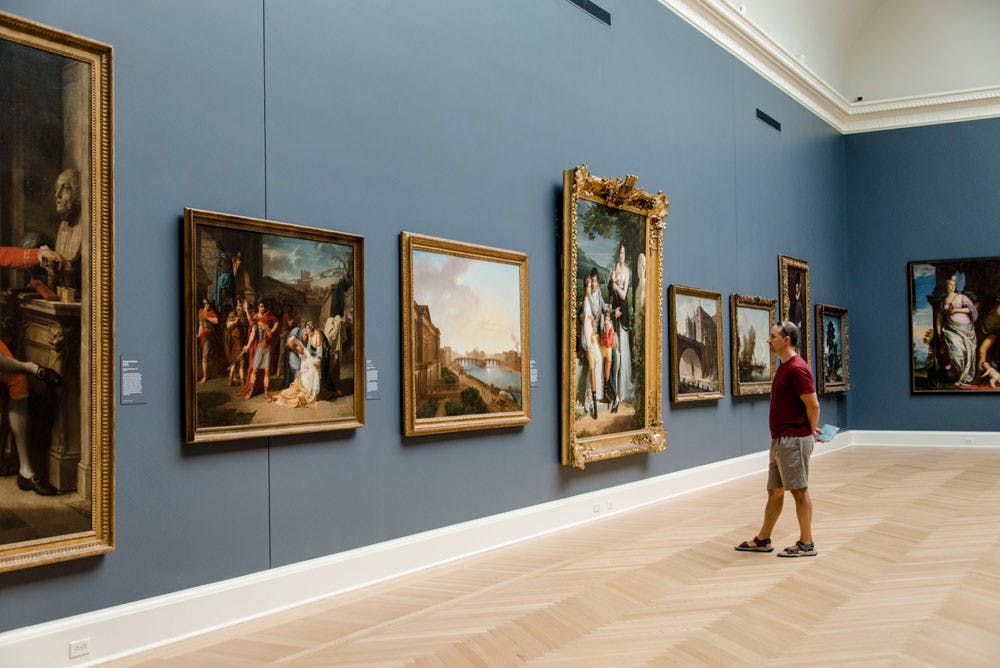Upon stepping onto the fifth floor of the Rhode Island School of Design Museum a year ago, viewers were transported 200 years back to Victorian-era salons. In the main gallery, which focuses on history paintings, artworks originally hung one on top of the other in an overwhelming display notable primarily for its sheer quantity. New fire safety codes in the aftermath of the Station nightclub fire in 2003 meant that the museum had to rework its galleries. Floor by floor, the museum has not only been working to meet codes, but also to very intentionally reinvigorate its spaces.
The main gallery on the fifth floor still contains the overwhelming portraits, excessive scenes of feasts and massive representations of religious imagery expected of a salon format. But now each work has an accompanying back story, said Maureen O’Brien, curator of painting and sculpture. The pieces lining the wall at eye level give viewers an opportunity to step closer to the art. With fewer works, observers can engage with each painting. For a moment, the observer can stand before “The Angel of Fame” painted by Giovanni Battista Tiepolo ca. 1750, which once guarded the palazzo of a newly rich family in Italy. Across from the “Angel,” “Thomas Estcourt, Esq.,” painted by Pompeo Girolamo Batoni on Estcourt’s Grand Tour, sits in the richest fashions of 1772, displaying in his portrait his determinacy to present himself as singularly well-read and cultured. Across the room, “Portrait of Antoine-Georges-Francois de Chabaud-Latour and His Family” painted by Jacques-Luc Barbier-Walbonne in 1806 shows a father telling his young daughter about her grandfather’s legacy. The opportunity to become immersed in works like these offers insight into the universal tendencies around image. The subjects, interested in displaying their success, have left a very self-conscious snapshot of their lifestyle.
In the next room, the viewers move away from traditional portraiture. In the 19th century, Paris salons began to give awards to paintings of landscapes. During this time, artists focused more on exhibiting the natural world. The way history was represented changed, O’Brien said. The ruins of monuments strewn across Roman landscapes as in “The Colosseum,” by Giovanni Paolo Pannini, or the hint of people dancing in the countryside as in “Tivoli,” by Jean-Victor Bertin, became the new access point for displaying the human story. In 1830, artists took landscape even further, choosing instead to portray completely untouched sceneries. “The purpose of landscape in art is for you to engage, emotionally, spiritually, intellectually with nature,” O’Brien said.
As the viewer continues through the exhibit, they encounter a gallery titled Painting Modern Life. In this room, paintings display both humans and landscapes, but the style has shifted entirely. As the Impressionist movement gained momentum and the works from the Salon des Refusés grew in cultural significance, artists began to experiment with the emotive quality of their style and subjects. In “The Basin at Argenteuil,” Monet recreated a landscape in an effort to capture its essence. The portraiture in this room does not express the same formality of the works in the main gallery. Manet’s painting, “Repose,” of Berthe Morisot depicts his subject resting comfortably on a sofa.
“It’s ground-breaking,” O’Brien said.
Coming out of the proceeding gallery, the viewer can physically experience the evolution of European art in the late 19th century. They encounter a space incorporating striking works by van Gogh, Berthe Morisot and Paul Cézanne, guiding their experience to the advance of modern art.
The Jean di Bona Gallery contains paintings that stray from the representational aspects of the works on the rest of the floor. “I pinch myself every day,” O’Brien said, referencing the collection which features the key players in the development of modern art. The room contains works by Matisse, Picasso and Braques, which, gathered in a single space, carry viewers through the 20th century.
The Creamer Medieval Gallery, which represents a sharp juxtaposition from the more modern spaces, imitates the setup of a church, displaying religious objects in an attempt to echo the way the pieces might have been used. A chasuble worn by clergy in the 1300s, a pyx from the 1200s and even a Romanesque portal give visitors an opportunity to engage with the objects in a way that feels relevant to their personal experience, O’Brien said.
Upon exiting the space devoted to religious art, the viewer enters the Creamer Early Renaissance Gallery, which reveals the more domestic side of historic art items. The gallery no longer contains walls dividing the room, creating a spacious corridor and contributing to an experience that breaks down the concerted themes of the previous galleries.
Though the floor focuses on European art, this section expands these borders, featuring work from different regions, said Brian Pletcher, a security officer on the fifth floor. Works include a plate encouraging fertility featuring the birth of Mary, decorative bowls and a Turkish cushion cover. Though the gallery lacks any particular timeline, the space highlights Venice as a port central to trade and the exchange of ideas.
The last gallery, a collection of portraits, returns to the idea of how subjects hoped to be portrayed after their deaths. Here, statues and paintings showcase ornate hairstyles and suits, expressing the subjects’ cultural values in an attempt at self-preservation. The gallery features the art historical equivalent of a selfie, O’Brien said.
“I’m just so impressed that’s a resource that students can have,” said Allison Lackey, a visitor in the gallery. Students can enter the RISD Museum free of charge, which grants them access to an entire chronology of European art and architecture on the fifth floor as well as art from across the world. The spaces are more than just a display: They’re an opportunity to interact closely with the works and just think, O’Brien said.





